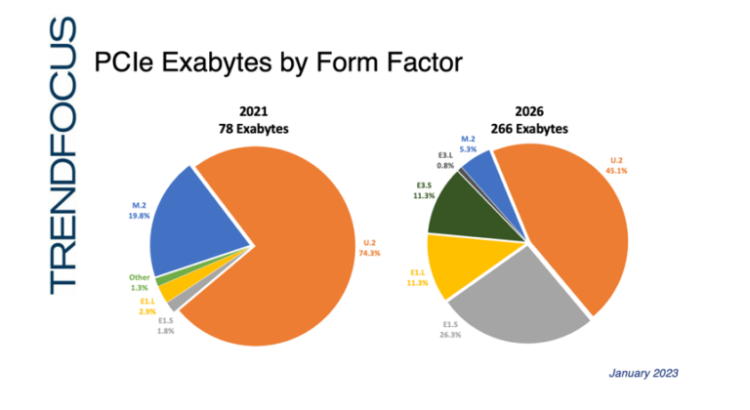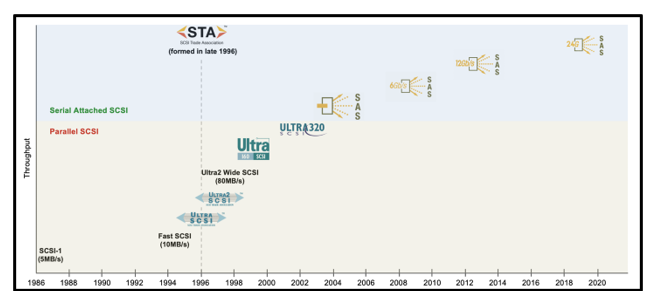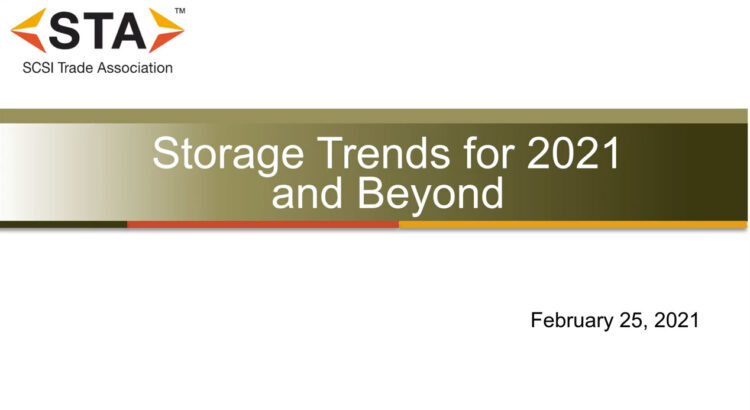
Category: Uncategorized

Connector and Cable differences: SAS-3 vs. SAS-4
By: David Einhorn, SCSI Trade Association Board of Directors; Business Development Manager, North America, Amphenol Corp., June 14, 2022
This blog post examines the differences between SAS-3 and SAS-4 connectors and cables. With the new generation of SAS, we see multiple upgrades and improvements.
Drive connector
[Note: 24G SAS uses the SAS-4 physical layer, which operates at a baud rate of 22.5Gb/s.]
The 29-position receptacle and plug connectors used in SAS-4 feature: hot-plugging, blind-mating, connector misalignment correction, and a PCB retention mechanism for robust SMT attachment. The connectors are SATA compliant and available across many suppliers in range of vertical and right-angle configurations. Typical applications are consistent with previous generations of server and storage equipment, HDDs, HDD carriers, and SSDs.
Read More
Questions & Answers from our January 2023 Webcast: Storage Trends in 2023 and Beyond
These questions were asked and mostly answered during our webcast, Storage Trends in 2023 and Beyond. Graphics included in this article were shown during the webcast, and several of the questions refer to the data in the charts.
Thank you to our panelists:
Don Jeanette, Vice President, TRENDFOCUS
Patrick Kennedy, Principal Analyst, ServeTheHome
Rick Kutcipal, At-Large Director, SCSI Trade Association and Product Planner, Data Center Solutions Group, Broadcom
Q1: What does the future hold for U.3? (SFF-TA-1001) Was it included in the U.2 numbers?
U.2 should be U.X in the pie chart. There are some shipments out there today, customers are taking it, and it will likely grow — but all the efforts and priorities are really E3S, E1S and then, to some extent, E1,L.
Read More
24G SAS: an Overview of the Technology & Products
Hyperscale and enterprise data centers continue to grow rapidly and to use SAS products as a backbone. Why SAS, and what specific SAS products are helping these data centers to grow? This article briefly discusses the technology evolution of SAS, bringing us to our latest generation of 24G SAS. We will examine recent market data from TRENDFOCUS, underscoring the established and growing trajectory of SAS products. We will highlight our latest plugfest, which smoothed the way for 24G SAS to seamlessly enter the existing data storage ecosystem. Finally, we will help the reader to understand the availability, breadth, and depth of 24G SAS products that are available today, and where you can get those products.
Read More
Dynamic Speakers on Tap for the 2022 SNIA Persistent Memory + Computational Storage Summit

Q&A (Part 2) from “Storage Trends for 2021 and Beyond” Webcast
Questions from “Storage Trends for 2021 and Beyond” Webcast Answered
This is part two of the Q&A portion of the roundtable talk between Rick Kutcipal, board director, SCSI Trade Association (STA); Jeff Janukowicz, Research vice president at IDC; and Chris Preimesberger, former editor-in-chief of eWeek, where they discussed prominent data storage technologies shaping the market. If you missed this webcast titled “Storage Trends for 2021 and Beyond,” it’s available on demand here.
Part One of the Q&A can be found at https://www.scsita.org/library/qa-part-1-from-storage-trends-for-2021-and-beyond-webcast/.

Q&A (Part 1) from “Storage Trends for 2021 and Beyond” Webcast
Questions from “Storage Trends for 2021 and Beyond” Webcast Answered
It was a great pleasure for Rick Kutcipal, board director, SCSI Trade Association (STA), to welcome Jeff Janukowicz, Research vice president at IDC and Chris Preimesberger, former editor-in-chief of eWeek, in a roundtable talk to discuss prominent data storage technologies shaping the market. If you missed this webcast titled “Storage Trends for 2021 and Beyond,” it’s now available on demand here.
The well-attended event generated a lot of questions! So many in fact, we’re authoring a two-part blog series with the answers. In part one, we recap the questions that were asked and answered during the webcast, but since we ran out of time to answer them all, please watch for part two when we tackle the rest.
Q&A from “SAS 201: An Introduction to Enterprise Features” Webcast
Questions from SAS 201 Webinar Answered
In an effort to provide ongoing educational content to the industry, the SCSI Trade Association (STA) tackled the basics of Serial Attached SCSI (SAS) in a webinar titled “SAS 201: An Introduction to Enterprise Features,” now available on the STA YouTube channel here.
Immediately following their presentations, our experts Rick Kutcipal of Broadcom and Tim Symons of Microchip Technology held a Q&A session. In this blog, we’ve captured the questions asked and answers given to provide you with insight on the recent evolutions in SAS enterprise features including 24G SAS and what they mean to system designers.
Q1. Do you think 24G SAS will only be applicable to SSDs, and HDDs will remain at 12Gb/s?
A1. Rick: At this time, hard disk drives (HDDs) can’t take advantage of the bandwidth that’s available in 24G SAS. And right now, the technology itself is focused on the backbone and then solid-state drive (SSD) connectivity. Currently, that’s the way we see it shaping up. Read More
Q&A from “SAS 101: The Most Widely-Deployed Storage Interface” Webcast
Questions from SAS 101 Webcast Answered
In an effort to provide ongoing educational content to the industry, the SCSI Trade Association (STA) tackled the basics of Serial Attached SCSI (SAS) in a webinar titled “SAS 101: The Most Widely-Deployed Storage Interface,” now available on demand here.
Immediately following their presentations, our experts Jeremiah Tussey of Microchip Technology and current STA Vice President; and former STA board member Jeff Mason of TE Connectivity, held a Q&A session. In this blog, we’ve captured the questions asked and answers given to provide you with the extra insight needed on why SAS remains the protocol of choice in the data center. Read More

A SNIA Superpower: PAS submitter to ISO
 SNIA’s Technical Council is one of the crown jewels of the organization. Made up of a group of acknowledged storage experts, the Technical Council oversees and manages SNIA Technical Work Groups, reviews architectures submitted by work groups, and is SNIA’s technical liaison to standards organizations.
One of the Council’s superpowers is its ISO JTC-1 designation as an ARO and a PAS submitter. What does that actually mean? It’s a very big deal!
SNIA is only one of 13 organizations worldwide that have the PAS submission capability, putting it in exclusive company. The list includes: Read More
SNIA’s Technical Council is one of the crown jewels of the organization. Made up of a group of acknowledged storage experts, the Technical Council oversees and manages SNIA Technical Work Groups, reviews architectures submitted by work groups, and is SNIA’s technical liaison to standards organizations.
One of the Council’s superpowers is its ISO JTC-1 designation as an ARO and a PAS submitter. What does that actually mean? It’s a very big deal!
SNIA is only one of 13 organizations worldwide that have the PAS submission capability, putting it in exclusive company. The list includes: Read More